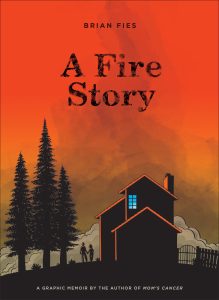 Ariana Fernow recently joined Pikes Peak Habitat staff as donor relations specialist. Ariana hails from Lincoln, Oregon, where her previous experience includes serving as a disaster recovery specialist for the Lincoln County School District following the Echo Mountain Complex fire of 2020. Over the past few weeks here in El Paso County, we’ve seen air-quality issues and smoke from wildfires raging in Colorado and throughout the American West. So this month’s read — recommended by Ariana — is especially timely for us: A Fire Story by Brian Fies.
Ariana Fernow recently joined Pikes Peak Habitat staff as donor relations specialist. Ariana hails from Lincoln, Oregon, where her previous experience includes serving as a disaster recovery specialist for the Lincoln County School District following the Echo Mountain Complex fire of 2020. Over the past few weeks here in El Paso County, we’ve seen air-quality issues and smoke from wildfires raging in Colorado and throughout the American West. So this month’s read — recommended by Ariana — is especially timely for us: A Fire Story by Brian Fies.
In this graphic memoir, Fies chronicles his experiences, as well as those of several of his neighbors and community members, during and after the Tubbs Fire in Northern California in 2017. Please note that during one particularly fraught scene, the book features language that some readers may find offensive.
Also, “I will say that it could be triggering, especially for individuals who have experienced a natural disaster,” Ariana notes. “I remember having a hard time reading through it myself. It was both triggering and cathartic because the author did such a great job writing and illustrating such an out-of-body, strange experience.”
Discussion Questions
What is your personal experience with fires or other natural disasters? Have you or people close to you been impacted? If so, how can you take care of yourself as you read this book and potentially revisit painful memories?
How does the graphic memoir format enhance or detract from the story for you? Why?
What do we learn about Fies and his family? In addition to his firsthand experience, why is he well-positioned to tell this story?
As well as telling his own story, Fies includes accounts of others who were impacted by the Tubbs fire. Why do you think he does this? Did one story particularly resonate with you? If so, whose and why?
On the night of the fire, why wasn’t the emergency notification system activated? How did most evacuees learn about the fire?
Fies notes that the fire didn’t discriminate between size and cost of the homes it burned, but the post-fire situation enhanced housing inequalities. What factors made renting and/or rebuilding especially challenging for those with fewer resources? What obstacles does he describe for people who didn’t lose their homes but lived in areas that were impacted?
Why did Fies and his family have “inadequate” insurance coverage? What did they discover when they tried to purchase sufficient coverage for their rebuilt home?
Why did they hold the utility company PG&E responsible for the fire? How might similar disasters be prevented in the future?
What did you learn about disaster response from this book? If you work with people who have been impacted by disasters, might you respond differently in the future as a result of reading this book? If so, how?

